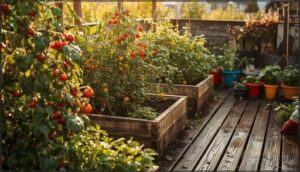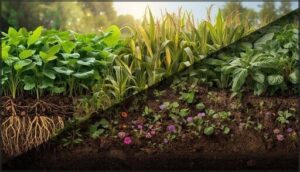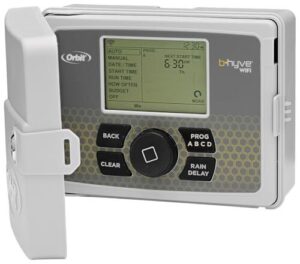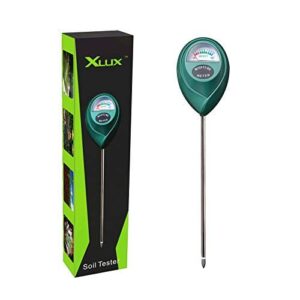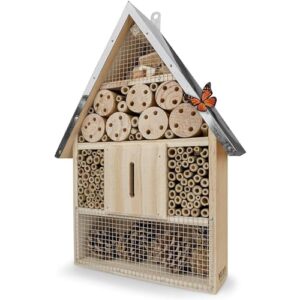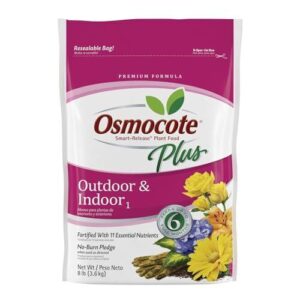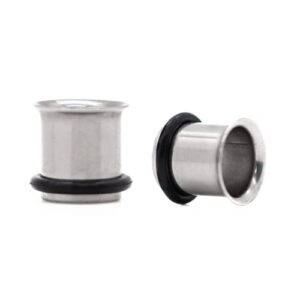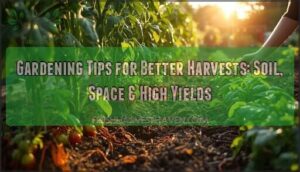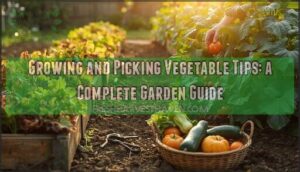This site is supported by our readers. We may earn a commission, at no cost to you, if you purchase through links.
Your garden’s potential sits locked in the space between what you’re doing now and what the soil, sun, and seeds could actually deliver. Most home growers leave significant yields on the table, not because they lack effort, but because small gaps in knowledge create big differences at harvest time.
A handful of adjustments to your soil fertility, watering patterns, and plant spacing can shift your garden from modest producer to reliable provider. The principles behind boosting homegrown crop yields easily aren’t complicated, they just require attention to the factors that matter most: matching plants to your conditions, feeding the soil rather than just the plants, and timing your interventions with the crop’s natural rhythms.
Table Of Contents
- Key Takeaways
- Essential Factors for High Home Crop Yields
- Smart Planting Techniques for Bigger Harvests
- Effective Pest and Disease Control Methods
- Advanced Soil and Water Management Tips
- Top 10 Products to Boost Home Crop Yields
- 1. Assorted Vegetable and Herb Seed Packets
- 2. Orbit B-hyve Smart Sprinkler Controller
- 3. XLUX Soil Moisture Meter Monitor Sensor
- 4. FLIR K2 Compact Thermal Camera
- 5. Lecravonic Pheromone Cologne for Men
- 6. Premium Weatherproof Wildlife Insect Hotel
- 7. Osmocote Smart Release Plant Food Plus
- 8. Polymer Sulfur Coated Urea Fertilizer
- 9. Surgical Steel Single Flare Tunnel Plug
- 10. Vaunn Medical Egg Crate Mattress Topper
- Frequently Asked Questions (FAQs)
- How can modern farming improve crop yields?
- How to increase the yield of a vegetable garden?
- How can pest and disease management improve crop yields?
- How to increase the yield of a vegetable garden in India?
- What is crop yield?
- How can I protect my yields?
- How do I know when to harvest my crops?
- Whats the best way to store homegrown produce?
- How can I extend my growing season naturally?
- Should I prune or pinch back my vegetable plants?
- Conclusion
Key Takeaways
- Soil quality drives harvest success more than any other factor, with pH testing between 6.0-6.8 and organic matter at 5-10% creating conditions where each 1% increase in organic content can boost yields by roughly 12%.
- Smart planting techniques like vertical gardening, succession planting every 2-3 weeks, and proper spacing transform limited space into continuous production, with vertical systems achieving up to 20-fold increases for leafy greens and succession methods delivering 30% more annual produce.
- Integrated pest management combining beneficial insects, disease-resistant varieties, and strategic monitoring cuts chemical use by up to 95% while protecting yields, with proper implementation often improving harvests by 10-30% through natural pest control.
- Water management through drip irrigation and soil moisture monitoring cuts water use by 50-75% while delivering precise hydration during critical growth stages, directly protecting harvest potential without wasting resources.
Essential Factors for High Home Crop Yields
Getting a great harvest from your home garden starts with understanding what your plants really need to thrive. You can’t control everything, but focusing on a few key factors makes a real difference in how much food you actually bring to the table.
Home garden success comes down to understanding and managing a few key factors that plants need to thrive
Let’s look at the essentials that set the stage for bigger, healthier yields in your backyard.
Soil Quality and Nutrient Management
Because your soil nutrition and health directly shape every harvest, you’ll want to start with nutrient testing to understand what’s actually happening underground. Here’s what matters most for soil quality:
- Test soil pH regularly – most crops thrive between 6.0 and 6.8, and testing removes guesswork
- Build organic matter to 5–10% – each 1% increase can boost yields by roughly 12%
- Apply fertilizer based on test results – this improves fertilizer efficiency and cuts waste by up to 20%
- Add compost or aged manure yearly – these amendments strengthen soil fertility and water retention naturally
Maintaining the correct pH ensures proper nutrient availability.
Climate and Weather Considerations
Temperature impacts and rainfall variability shape your harvest more than you might realize. A 1°C rise can cut wheat yields by 6%, while consistent wet conditions boost productivity by 8–9%. Here’s what weather means for your garden:
| Weather Factor | Impact on Yields |
|---|---|
| High temperatures (>30°C) | Up to 6% daily loss |
| Frost events (2–10/season) | 30%+ reduction in susceptible crops |
| Rainfall deficits | Leading cause of decline |
| Urban microclimates | 12–20% yield increase |
| Extreme events (floods, storms) | 60–100% immediate loss |
Climate-smart farming means adapting to these realities through weather forecasting and microclimate modification. Higher CO2 levels, however, can increase photosynthesis rates, benefiting some crops.
Plant Genetics and Seed Selection
Beyond the weather’s whims, your seed choices can reshape everything. Hybrid seed varieties often deliver 60% higher yields through targeted breeding, while heirloom varieties offer genetic diversity but generally produce less. Disease resistance and stress tolerance matter deeply—especially when bacterial blight or nematodes strike.
Consider these priorities:
- Select disease-resistant seed varieties aligned with local pest pressures
- Balance hybrid performance against NonGMO options for your values
- Use selection indices that weigh seed weight, number, and resilience
- Match high-yield varieties to your microclimate and soil conditions
Smart seed selection builds harvest security from the ground up.
Optimal Plant Spacing and Density
Once you’ve chosen your seeds, spacing shapes how well they’ll actually perform. Crowded plants battle for light and nutrients, lowering yields and boosting disease prevalence by up to 30%.
Square-foot gardening and spacing charts offer proven frameworks: leafy greens thrive at 3–4 inches apart, tomatoes need 24–36 inches.
Proper plant density balances resource competition with canopy coverage, optimizing yields while supporting healthy air circulation through intensive planting methods and vertical trellis systems.
Water Management and Irrigation
Without enough water at the right time, your yields drop fast. Drip irrigation cuts water use by 50–75% while delivering moisture straight to roots, and smart controllers paired with soil moisture monitoring help you water properly during peak uptake windows.
Rainwater harvesting supplements municipal sources, and irrigation timing around critical growth stages protects both water conservation goals and your harvest potential.
Smart Planting Techniques for Bigger Harvests
Once you’ve got the basics down, the way you arrange and organize your plants can make all the difference in how much food you actually harvest. Small changes in how you position crops, when you plant them, and what you grow together can dramatically increase your yields without requiring more space or resources.
Let’s look at some practical planting strategies that help you get more from every square foot of your garden.
Raised Beds and Container Gardening
Raised beds and container gardening give you precise control over soil composition, which directly improves home crop yields through better drainage and nutrient management. Raised beds can double or triple your harvests compared to traditional in-ground plots, while containers offer space optimization for patios and balconies.
Both methods provide accessibility benefits, reducing strain during planting and harvest, and their enhanced water drainage helps prevent root problems that limit productivity.
Vertical and Succession Planting
Vertical gardening and succession planting transform limited space into a powerhouse of productivity. Stacking crops upward can increase home crop yields up to 20-fold for leafy greens, while succession planting—sowing new batches every two to three weeks—ensures continuous harvest throughout the season.
- Vertical systems achieve 50–100 times more yield per square foot through dense stacking and year-round indoor gardening cycles
- Succession planting delivers 30% more annual produce by maintaining constant bed productivity between harvests
- Space optimization with vertical structures allows 28 times more plants per square foot compared to traditional arrangements
- Resource efficiency improves dramatically, with vertical farms using 70–95% less water through precise recycling systems
- Yield stacking in controlled environments produces up to 10 planting cycles yearly versus 2–3 outdoors, maximizing increasing crop yields
Crop Rotation and Intercropping
Rotating crops and intercropping multiple species transform your garden’s productivity while reducing pest pressure. You’ll see soil health improvements when legumes and cover crops increase nitrogen by up to 50%, and intercropping delivers 28% greater yields than monocultures. These methods create natural pest suppression, cutting outbreaks by 25%, while stabilizing your harvests and lowering fertilizer costs by 12–32%.
| Rotation Benefits | Intercropping Methods |
|---|---|
| 50% nitrogen boost from legumes | 28% higher yields than monoculture |
| 25% fewer pest outbreaks | 1.5 t/ha additional grain production |
| 48% corn yield increase (4-year rotation) | 19% land savings through diversity |
| 12–32% reduced fertilizer costs | 84–87% of trials show yield gains |
| Enhanced soil microbial diversity | Natural pest control without chemicals |
Companion Planting Strategies
Pairing the right plants together acts as your garden’s natural defense system, with companion plantings boosting yields by 20–35% while cutting pest pressure. Intercropping carrots with onions slashes carrot fly infestations by 52%, and borage near strawberries increases harvests by 32%.
You’ll attract more pollinators, improve soil fertility, and build biodiversity that strengthens pest control without chemicals—all through strategic crop rotation and smart plant combinations.
Effective Pest and Disease Control Methods
Keeping pests and diseases in check doesn’t mean reaching for harsh chemicals right away. You can protect your crops using methods that work with nature, not against it, and still get excellent results.
Let’s look at four practical approaches that’ll help you maintain healthy plants while keeping the garden ecosystem balanced.
Integrated Pest Management (IPM)
You can think of Integrated Pest Management like building a defense system that works with nature, not against it. IPM principles combine monitoring, biological controls, and targeted pesticide reduction—cutting insecticide use by up to 95% in some crops.
This approach delivers economic benefits by lowering costs while protecting ecosystem services. Though future challenges include managing pest resistance, IPM’s pest control strategies prove that less chemical intervention often means healthier yields.
Promoting Beneficial Insects
Beyond monitoring alone, you’ll want to roll out the welcome mat for pest predators and garden pollinators. More than 97% of insects are beneficial or benign, contributing an estimated $34 billion annually in U.S. pollination services. Insect hotels, native plantings, water sources, and organic products create habitats that support mixed plantings. These beneficial insects deliver effective organic pest control, often improving yields by up to 30% when managed correctly.
- Install insect hotels in sunny, undisturbed spots to provide shelter and breeding sites
- Plant diverse native flowers to attract pollinators and predatory wasps
- Offer shallow water sources alongside flowering borders for beneficial insect populations
- Use organic products and avoid broad-spectrum pesticides to protect natural pest control allies
Using Disease-resistant Plant Varieties
Choosing the right seed selection and genetics gives your crops a head start against disease. Disease-resistant plant varieties can prevent up to 14% of crop losses and boost home garden yields by 10–25% under disease pressure.
Over 60% of new vegetable seeds now carry resistance traits, and you’ll cut fungicide use by up to 60% while enjoying longer harvests and healthier plants.
Organic and Biological Pest Control
While disease-resistant varieties build your defense, organic pest control and biological methods add another protective layer. In 2024, 81% of pest management professionals used natural products, reflecting strong market trends.
Biopesticide efficacy is proven—integrated pest management strategies reduced aphid outbreaks by 50–90% in field trials.
You’ll support beneficial insects through habitat management while cutting chemical use, creating healthier crops and soil for long-term success.
Advanced Soil and Water Management Tips
Once you’ve handled the basics of pest control, it’s time to think about what’s happening beneath your plants. Healthy soil and smart water use are the foundation of consistent, productive harvests year after year.
Let’s walk through some practical techniques that’ll help you build better soil, conserve water, and grow stronger crops right in your own backyard.
Composting and Mulching Practices
You can transform your garden soil by combining composting and mulching practices—two approaches that feed each other. Composting prevalence has surged, with nearly 80% of U.S. composting happening at home. Your compost soil fertility improves dramatically, potentially replacing up to 40% of synthetic fertilizers.
Meanwhile, mulching drives yield improvement, boosting harvests by 10-20% while reducing evaporation. Together, these organic matter additions strengthen soil health effects and nutrient management far beyond what synthetic options provide.
Managing Soil PH and Fertility
Since soil pH testing every 3 to 5 years helps you spot nutrient deficiencies early, you’ll want to start there. Most vegetables thrive between pH 6.0 and 6.8, where nutrient management works best.
If your fertility needs adjustment, lime application raises acidity while sulfur lowers it. These organic amendments build nutritious soil gradually, ensuring your crops access the nutrients they need for strong growth.
Drip Irrigation and Smart Controllers
When you switch to drip irrigation systems, you’ll achieve 90 to 95 percent water use efficiency compared to just 50-70 percent with overhead sprinklers. Smart controllers cut water use by another 15-40 percent through weather data and automated scheduling, making economic considerations worthwhile despite the $200-$850 upfront cost.
Drip system maintenance stays simple with filters and pressure regulators, while technological innovations like IoT connectivity give you real-time control over watering and irrigation systems.
Soil Moisture Monitoring Techniques
How accurately can you track your soil’s water levels at home? Soil moisture monitoring techniques range from simple feel methods, accurate within 10 percent, to sophisticated soil sensors with data integration that deliver precision under 1 percent error.
Remote sensing and smart irrigation controllers now support real-time water management decisions.
Despite adoption barriers like upfront costs, cost-effectiveness improves considerably across multiple growing seasons through optimized watering and irrigation systems.
Cover Cropping and Green Manuring
Cover cropping and green manuring turn off-season fields into fertility factories, building organic matter while cutting erosion by up to 90 percent. You’ll see clear economic benefits, often breaking even within 6 to 18 months through reduced fertilizer costs and better water conservation.
For species selection and soil health improvement, consider:
- Cereal rye for weed suppression and nutrient cycling boost
- Turnips to break compaction and capture excess nitrogen
- Annual ryegrass for erosion control and soil fertility
- Oats for quick establishment in crop rotation systems
Top 10 Products to Boost Home Crop Yields
The right tools can make all the difference when you’re working to increase your home garden’s productivity. From seed selection to irrigation management and soil monitoring, targeted products help you address the specific challenges that limit yields.
Here are ten recommended products that can support your efforts to grow more food at home.
1. Assorted Vegetable and Herb Seed Packets
You’ll find that seed packet diversity matters more than you might think—assorted vegetable and herb seed packets give you access to multiple plant varieties in one purchase, and quality matters. Look for heirloom vs. hybrid options depending on your goals, since germination rates can exceed 90% with fresh, properly stored packets.
Bulk seed benefits include cost savings and the chance to trial high-yield varieties, but storage impact yields over time, so keep packets cool and dry to maintain those strong germination rate factors and amplify your harvest success.
Best For: Home gardeners who want to experiment with a wide range of vegetables and herbs without committing to single varieties, especially those looking to build seed diversity for year-round planting.
- Over 10,000 non-GMO heirloom seeds across 43 varieties give you tons of options to test what grows best in your space and climate.
- High germination rates (7-14 days) and included Mylar storage bag help keep seeds viable longer when stored properly.
- Cost-effective way to stock up compared to buying individual packets, plus you can save seeds from open-pollinated varieties for future seasons.
- Seed counts are listed by weight rather than actual numbers, making it harder to plan exactly how many plants you’ll get.
- Up to 32% of packets may be duplicates, so you might not get the full variety promised.
- Basic growing instructions mean you’ll likely need to research specific planting depths, spacing, and care for each variety on your own.
2. Orbit B-hyve Smart Sprinkler Controller
When irrigation systems waste water, your crops suffer and bills climb—that’s where the Orbit B-hyve Smart Sprinkler Controller changes everything. This EPA WaterSense-certified smart irrigation device uses WeatherSense tech to adjust watering schedules automatically, responding to rainfall and humidity for precise water conservation.
You’ll gain remote access through your smartphone, managing up to 16 zones with smart scheduling that divides watering into phases, optimizing soil absorption while preventing runoff. Most users report measurable water savings within months, and drip irrigation compatibility makes this controller a practical choice for home growers.
Best For: Homeowners looking to cut water bills and automate their lawn or garden irrigation with smart, weather-responsive scheduling.
- Saves serious water—over 100 billion gallons conserved globally since 2016, with most users seeing lower utility bills within a few months.
- Manages up to 16 zones with customizable schedules, soak cycles, and remote smartphone control via dual-band WiFi and Bluetooth.
- EPA WaterSense certified with WeatherSense technology that automatically adjusts watering based on local rainfall and humidity.
- May have WiFi compatibility issues with certain routers, and international users should check voltage requirements (110V).
- Requires a separate rain sensor for the most accurate rain detection and responsiveness.
- Not all sprinkler systems are compatible, so you’ll want to verify functionality before full installation.
3. XLUX Soil Moisture Meter Monitor Sensor
While smart controllers automate irrigation systems, knowing when soil actually needs water demands real-time monitoring—that’s where the XLUX Soil Moisture Meter proves valuable. This battery-free analog device provides immediate readings across a ten-point scale, helping you improve watering techniques and avoid overwatering by up to 70%.
Market analysis shows analog sensors remain popular for their simplicity, though durability issues arise with heavy use. Meter accuracy can decline over time, so clean the probe after each check and don’t leave it inserted beyond five minutes for reliable soil moisture data.
Best For: Home gardeners who want a simple, battery-free way to check soil moisture and prevent overwatering without dealing with app setup or calibration.
- Gives you instant moisture readings the moment you stick it in the soil—no waiting, no batteries, no hassle.
- Works both indoors and outdoors, so you can use it for houseplants, garden beds, or containers anywhere.
- Affordable and easy to read with a clear dial that shows whether your soil is dry, moist, or wet at a glance.
- Accuracy drops over time, and some users report it starts giving false “dry” readings even when soil is moist.
- The probe can break after just a few uses, especially in harder or rockier soil.
- You need to remove it after each check and keep it clean, or it’ll corrode and stop working reliably.
4. FLIR K2 Compact Thermal Camera
Beyond testing soil moisture directly, you can now visualize hidden irrigation issue detection and thermal crop analysis using the FLIR K2 Compact Thermal Camera. This rugged device reveals temperature variations across your garden beds, helping identify disease pattern ID before symptoms appear and supporting yield estimation through canopy heat mapping.
The 160 × 120 pixel resolution detects soil salinity stress and guides smart irrigation timing by showing which plants need water first. While originally designed for firefighting, this thermal camera transforms crop yield monitoring and water management for serious home growers seeking data-driven soil health insights.
Best For: Home gardeners and small-scale growers who want a simple, rugged tool for spotting irrigation problems and monitoring crop health using thermal imaging.
- Easy single-button operation, even with gloves
- Accurately visualizes temperature differences for early stress and disease detection
- Rugged, water-resistant, and drop-proof design for outdoor use
- Refresh rate is slow, taking about 3 seconds for updates
- Moderate resolution limits detail on small plants or tight spaces
- Software compatibility issues with Mac computers
5. Lecravonic Pheromone Cologne for Men
Now here’s something different: Lecravonic Pheromone Cologne for Men doesn’t belong in your garden toolkit. While human pheromone products claim to boost romantic attention and user confidence through scent attractiveness affecting social interactions, studies show placebo effects account for 26–40% of reported results.
Unlike integrated pest management strategies that use beneficial insect pheromones for organic pest control, this cologne offers zero value for crop yields. Save your dollars for real gardening tools that actually support plant health and productivity.
Best For: Men looking for a subtle everyday cologne who are curious about pheromone-infused fragrances and don’t mind that the attraction-boosting claims lack strong scientific backing.
- Natural essential oil blend creates a fresh, versatile scent suitable for both work and social settings.
- Comes in elegant packaging at 1.7 fluid ounces, making it a decent gift option for men.
- Some users report increased confidence when wearing it, though this may be partly due to placebo effect.
- Scent longevity is inconsistent—many users report it fades within 4-5 hours instead of lasting all day.
- Pheromone effectiveness is questionable, with studies showing 26-40% of positive results come from placebo effect rather than actual chemical attraction.
- The fragrance concentration is eau de cologne (lighter), so it won’t satisfy those who prefer bolder, longer-lasting scents.
6. Premium Weatherproof Wildlife Insect Hotel
While pheromones won’t help your garden, beneficial insects certainly will. A premium weatherproof insect hotel provides year-round shelter for pollinators and predators that boost your harvests.
Studies show insect pollination can increase crop yields by 18–71%, while ladybugs and lacewings reduce aphid populations by up to 90%.
Look for a model with a metal roof extending 2–3 inches beyond the structure, offering 30% better rain protection.
Just remember maintenance challenges—you’ll need to clean nest tubes annually to prevent parasitism rates from climbing above 35%.
Best For: Gardeners and eco-conscious homeowners who want to support pollinators and natural pest control while adding a functional, attractive feature to their outdoor space.
- Proven results—can boost crop yields by 18–71% and cut aphid populations by up to 90% with the right beneficial insects taking up residence.
- Weatherproof design with a metal roof that extends beyond the structure, cutting rainwater damage by 30% and lasting through multiple seasons.
- Versatile placement options for gardens, balconies, or walls, with different chambers that attract a variety of helpful insects like solitary bees, ladybugs, and lacewings.
- Requires annual cleaning and maintenance to keep parasitism rates below 35%—neglect can drop occupancy by over 50% within two years.
- Takes time and the right sunny location to attract inhabitants, and some users report that certain sections (like butterfly chambers) don’t get much use.
- Shipping issues reported by some buyers, including missing parts or damage on arrival that can delay setup.
7. Osmocote Smart Release Plant Food Plus
If you’re looking for a fertilizer that takes the guesswork out of nutrient management, Osmocote Smart Release Plant Food Plus delivers. Its resin-coated granules provide nutrient release control for up to six months, feeding your crops steadily without the risk of burning—even at triple the recommended rate.
Field trials show this slow-release formula can boost crop yield impact by 30% compared to standard fertilizers, while its longevity stability means you’ll apply it just once or twice per season instead of four to six times, saving both time and money.
Best For: Gardeners who want a set-it-and-forget-it fertilizer that feeds plants consistently for months without frequent reapplication or risk of burning.
- Feeds for up to 6 months with just one application, cutting down fertilizing sessions from 4-6 times to 1-2 times per season.
- Field trials show up to 30% higher crop yields compared to conventional fertilizers, with improved fruit quality and plant vigor.
- Safe and forgiving formula won’t burn plants even if you accidentally use three times the recommended amount.
- Needs reapplication every 6 months to maintain effectiveness, so you’ll need to mark your calendar for the next feeding.
- Indoor plants require half the outdoor rate, which means you’ll need to measure carefully depending on where you’re using it.
- Not suitable for forage crops intended for livestock feed due to elevated molybdenum levels that can harm ruminant animals.
8. Polymer Sulfur Coated Urea Fertilizer
For home gardeners working with sandy or leach-prone soils, polymer sulfur coated urea fertilizer offers a controlled release advantage that conventional options can’t match. This enhanced efficiency product extends nutrient availability up to 60 days, reducing nitrogen losses by 40% while improving soil fertility with every application.
Field data shows yield increases of 10–18% in nutrient-deficient conditions, and its environmental impact stays minimal—cutting ammonia emissions nearly in half. One seasonal fertilization often covers your crops’ needs, simplifying nutrient management while supporting stronger plant growth.
Best For: Home gardeners and small-scale growers working with sandy or nutrient-poor soils who want a low-maintenance, season-long fertilizer that reduces environmental impact while boosting plant health.
- Extends nutrient release up to 60 days and cuts nitrogen loss by 40%, so you fertilize once instead of multiple times per season.
- Boosts yields by 10–18% in nutrient-deficient conditions while reducing ammonia emissions by nearly half compared to standard urea.
- Works especially well in sandy or high-rainfall areas where regular fertilizers wash away quickly, saving you money and effort over time.
- Costs significantly more upfront than conventional urea, which may be a barrier for budget-conscious gardeners despite long-term savings.
- Requires understanding of soil type and crop needs to maximize benefits—not as foolproof as standard fertilizers for beginners.
- Availability can be limited in some regions, and the product may not be stocked at all local garden centers or agricultural suppliers.
9. Surgical Steel Single Flare Tunnel Plug
This product doesn’t relate to improving crop productivity or home gardening techniques, so you won’t find stretching benefits or steel biocompatibility improving yields in your garden beds.
While surgical steel single flare tunnel plugs demonstrate durability and low allergy risks for body jewelry use, they offer no essential factors affecting home crop yield.
Home growers need tools that directly support plants—like irrigation systems or soil amendments—not accessories designed for ear gauging. Sizing accuracy matters for piercings, but this item simply doesn’t fit into strategies for boosting harvests.
Best For: People stretching their ears who want affordable, hypoallergenic jewelry that’s comfortable for everyday wear and works well for sensitive skin.
- Made from 316L surgical steel that resists tarnish and corrosion, so it lasts for years even with daily wear or exposure to moisture.
- Hypoallergenic material with nickel release well below safety standards, making it suitable for most people with metal sensitivities.
- Single-flare design with o-rings makes insertion easy and keeps the plugs secure without adding extra weight or bulk.
- The metal can be thin with sharp edges, which some users find uncomfortable or irritating during wear.
- Tunnel length may be too long for people with smaller earlobes, causing fit issues or discomfort.
- Sizing accuracy isn’t always consistent, and some people with severe nickel allergies may still experience reactions despite the low nickel content.
10. Vaunn Medical Egg Crate Mattress Topper
This product won’t support yield improvement or effective gardening techniques in your growing space, despite its medical-grade design offering pressure sore relief and airflow and cooling through convoluted foam.
The Vaunn Medical Egg Crate Mattress Topper, with product dimensions of 79″ x 35″, is suitable for hospital beds and home healthcare needs.
Market analysis shows North America’s mattress topper segment reached $380.56 million in 2024, but topper durability of 2-3 years matters only for bedridden patients, not home growers seeking crop yields through home gardening techniques.
Best For: Healthcare facilities and home caregivers managing bedridden patients who need pressure ulcer prevention and relief from back or neck pain.
- Medical-grade urethane foam distributes weight evenly to reduce pressure sores and improve blood circulation, especially for patients with limited mobility.
- Convoluted egg crate design increases airflow by up to 30% compared to flat foam, keeping sleepers cooler and reducing moisture buildup.
- Hypoallergenic and chemical-free construction (no lead, mercury, formaldehyde, or phthalates) makes it safe for sensitive skin and long-term use.
- Foam typically needs replacement every 2-3 years as it compresses and develops permanent indentations that reduce effectiveness.
- Fresh foam smell can linger for 3-5 days after unpacking, and full expansion takes several days after shipping.
- Hospital twin size (79″ x 35″) may not fit standard home mattresses, and some users report the topper being smaller than expected.
Frequently Asked Questions (FAQs)
How can modern farming improve crop yields?
Work smarter, not harder” rings true in agriculture. Modern farming leverages precision agriculture, genetic modification, smart irrigation, IPM strategies, and automation robotics to greatly boost crop yields while enhancing soil fertility and sustainable agriculture practices.
How to increase the yield of a vegetable garden?
Yield improvement in your vegetable garden starts with soil fertility management, proper watering and irrigation techniques, strategic pest control, maximizing sunlight exposure, and employing smart pruning techniques, support structures, pollination strategies, and ideal harvest timing.
How can pest and disease management improve crop yields?
Think of your garden as a battlefield where prevention wins the war. IPM strategies, combining biological controls and disease-resistant varieties, reduce losses by up to 40%, protecting your harvest while decreasing pesticide costs greatly.
How to increase the yield of a vegetable garden in India?
Focus on soil fertility through compost and balanced nutrients, and adopt drip irrigation for water management.
Use pest control methods like neem spray, and select climate-resilient regional varieties.
Improve space usage with vertical planting for yield improvement.
What is crop yield?
Crop yield measures how much you harvest from a given area, usually in kilograms per hectare.
It’s your key productivity indicator, helping identify yield gaps between actual harvests and potential crop production.
How can I protect my yields?
You can’t overestimate physical barriers like row covers and bird netting—they’re game-changers for pest control and disease prevention.
Combining IPM strategies with climate resilience, water management, and organic pest control ensures integrated disease management.
How do I know when to harvest my crops?
Watch for visual indicators like color changes, firmness, and size to determine harvest readiness.
Proper timing during the growing season maximizes garden productivity and nutritional impact while reducing post-harvest loss for your bountiful harvest.
Whats the best way to store homegrown produce?
Your homegrown produce needs the right temperature and humidity levels—think old-fashioned root cellaring meets modern monitoring practices.
Best container materials and preservation methods, combined with proper post-harvest handling techniques, maintain crop quality and extend storage life effectively.
How can I extend my growing season naturally?
You can extend your growing season naturally using row covers, cold frames, and mulch benefits to protect plants from frost.
Succession planting with fall crops, tunnel types, and using microclimates also increase harvest periods.
Should I prune or pinch back my vegetable plants?
Yes, you should prune or pinch back most vegetable plants. Pruning improves air circulation, reduces disease risk, and can increase fruit size, while pinching encourages bushier growth and more fruiting sites.
Conclusion
Every tomato you don’t harvest, every zucchini that underperforms, represents a decision made months earlier. Boosting homegrown crop yields easily comes down to stacking small advantages: better soil, smarter water use, strategic planting choices.
The difference between disappointing seasons and abundant ones isn’t mysterious, it’s methodical. Your garden won’t transform overnight, but each adjustment compounds.
Start with one change this week, another next month. The harvest you want is already within reach.
- https://soilhealthinstitute.org/app/uploads/2022/01/100-Farm-Fact-Sheet_9-23-2021.pdf
- https://pmc.ncbi.nlm.nih.gov/articles/PMC11467207
- https://sustainability.stanford.edu/news/reduced-soil-tilling-helps-both-soils-and-yields
- https://agricology.co.uk/resource/compost-effect-nutrients-soil-health-and-crop-production
- https://www.epa.gov/sustainable-management-food/benefits-using-compost


